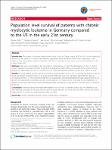Population level survival of patients with chronic myelocytic leukemia in Germany compared to the US in the early 21st century
Pulte, Dianne
Barnes, Benjamin
Jansen, Lina
Eisemann, Nora
Emrich, Katharina
Gondos, Adam
Hentschel, Stefan
Holleczek, Bernd
Kraywinkel, Klaus
Brenner, Hermann
Introduction: The advent of tyrosine kinase inhibitors has produced 5-year survival of 90 + % for chronic myelocytic leukemia (CML) patients in clinical trials. However, population level survival has been lower, especially in older patients. Here, we examine survival of patients with CML in Germany and compare it to survival of patients in the United States (US). Methods: Data were extracted from the Surveillance, Epidemiology, and End Results database in the US and 11 cancer registries in Germany. Patients 15–69 years old diagnosed with CML were included in the analysis. Period analysis for 2002–2006 was used to provide the most up-to-date possible estimates of five-year relative survival. Results: Five-year relative survival was 68.7% overall in Germany and 72.7% in the US. Survival was higher in the US for all age groups except for ages 15–39 years, but the difference was only statistically significant for ages 50–59 years (at 67.5% vs 77.7% in Germany and the US, respectively). Survival decreased with age, ranging from 83.1% and 81.9%, respectively, in Germany and the US for patients 15–39 years old to 54.2% and 54.5%, respectively, in patients 65–69 years old. Survival increased between 2002 and 2006 by 12.0% points in Germany and 17.1% points in the US. Conclusions: Five-year survival estimates were higher in the US than in Germany overall, but the difference was only significant for ages 50–59 years. Survival did not equal that seen in clinical trials for either country, but strong improvement in survival was seen between 2002 and 2006.
No license information

